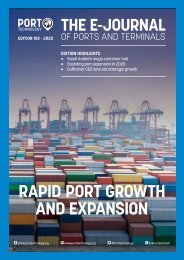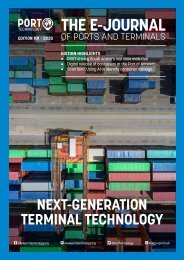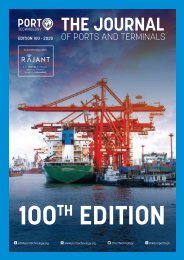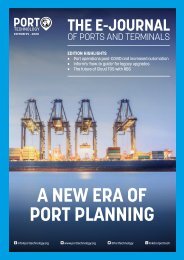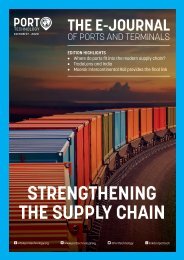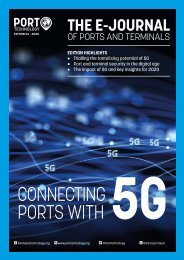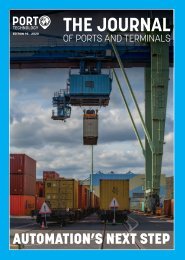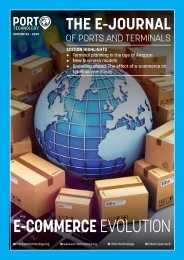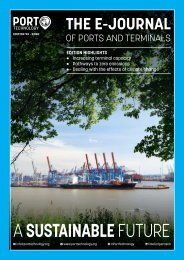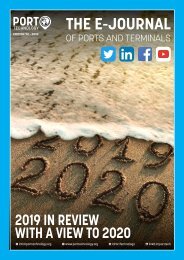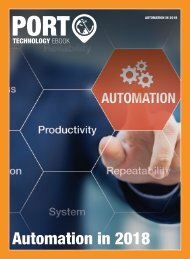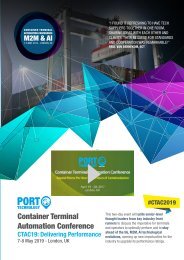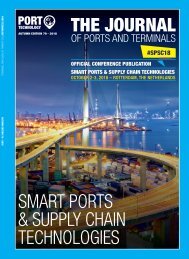Automation Innovations
As we enter the second half of 2020 the full effects of the COVID-19 pandemic are now being realised across the global economy and the port industry. For many, cargo throughput has been significantly decreasing compared with the same period for 2019. For example, the Port of Los Angeles handled 581,665 TEUs in May, a 29.8
As we enter the second half of 2020 the full effects of the COVID-19 pandemic are now being realised across the global economy and the port industry. For many, cargo throughput has been significantly decreasing compared with the same period for 2019.
For example, the Port of Los Angeles handled 581,665 TEUs in May, a 29.8
Create successful ePaper yourself
Turn your PDF publications into a flip-book with our unique Google optimized e-Paper software.
AUTOMATION INNOVATION<br />
CONCLUSION<br />
For a non-automated terminal, the path<br />
to improve efficiency and safety is not<br />
only automating CHE handling and reducing<br />
labour cost. Making things easier and<br />
simpler for the CHE operators and automating<br />
non added value tasks, will provide<br />
efficiency and safety improvements at an<br />
affordable cost.<br />
Integrating real-time operation into a<br />
dashboard, along with updated activity visualization,<br />
also will help the Terminal Management<br />
to take better decisions, increasing<br />
the overall performance of the terminal.<br />
not granting twist-lock operation, to ensure<br />
that the container will not be lifted from that<br />
truck.<br />
Health and safety business rules are automatically<br />
applied, as in example, displaying<br />
plugged-in reefers to avoid handling containers<br />
which may lead to pull out cables, showing<br />
up twin carry pairs subject to be loaded<br />
in twin or single lift , to ensure the CHE operator<br />
adjust properly the gap, etc.<br />
A complete context information is provided<br />
to CHE operators to make their work<br />
easier. For instance, TT’s Point of Work<br />
(POW) can be seen in the job list, container<br />
net load, length or type are available, main<br />
work instruction details are highlighted, etc.<br />
A full set of business rules controls and automation<br />
are provided in the CHE GUI. These<br />
rules combined with the availability of context<br />
information offered to the operator and<br />
smart advisors, make the operations more<br />
efficient and reduce dramatically the manual<br />
errors, which results in better productivity<br />
and better information quality in TOS. As<br />
the business rules tend to change over time<br />
when operations procedures are being improved,<br />
a configurable drag & drop GUI is<br />
provided to IT Administrators for updating<br />
the business rules without programming.<br />
These business rules allow the CHE operator<br />
to address any unforeseen problem, like<br />
TT’s RFID reading error, manual remarshalling,<br />
inventory inconsistencies, etc. One big<br />
advantage of the CHE GUI is to provide the<br />
TOS with all the necessary information to<br />
keep yard inventory fully updated, preventing<br />
future problems that affect productivity.<br />
With the new Advanced CHE GUI, the<br />
operator focusses on driving and manual<br />
tasks to be accomplished, while the system<br />
automates a lot of check-ups and TOS interaction<br />
to boost productivity and keep the<br />
yard inventory properly updated.<br />
ADVANCED FLEET MANAGEMENT SYSTEM<br />
Terminal Trucks at CSP have been equipped<br />
with Orbita’s black-box devices, which are<br />
in fact IoT gateways, that gather, among<br />
other signals, GPS location. These locations<br />
are being updated and sent every second<br />
to a central stream processor to have the<br />
fleet location permanently up to date.<br />
Once the exact location of each TT is<br />
known, dynamic geofencing rules are being<br />
applied related to the assigned work instructions.<br />
When the TT arrives at the origin<br />
location, for instance a Sea to Shore (STS)<br />
crane to receive a container, a progress update<br />
is automatically reported to the TOS.<br />
When the TT reaches the destination of<br />
the work instruction, for instance a CHE to<br />
deliver the container, another progress update<br />
is automatically submitted to the TOS.<br />
This will mean that no manual intervention<br />
of the TT driver will be needed as job-stepping<br />
will be a full automated process.<br />
Not only progress is done at the origin<br />
and destination. TT’s locations are periodically<br />
reported to the TOS at a configurable<br />
time, to allow the TOS, to perform a better<br />
scheduling and dispatching of work instructions.<br />
To improve further the automation of previously<br />
manual tasks, each time the TOS assigns<br />
a new work instruction to a TT, the system<br />
reconfigures the radio trunking system<br />
of the TT to automatically select the radio<br />
channel of the POW the driver is driving towards.<br />
This is the way to let TT drivers always<br />
have available a direct communication with<br />
the Quay Crane (QC) operator and QC checker<br />
he is going to deliver or get a container.<br />
Less manual and non-added value interactions<br />
mean safer operations for the drivers,<br />
less mistakes in the operations and less<br />
time reporting to the TOS, which all lead to<br />
an increase of efficiency and safety in the<br />
operations at the terminal.<br />
The fleet management system also allows<br />
the Terminal Management to have a realtime<br />
picture of TT and STS locations. This<br />
graphical view also displays the activity being<br />
performed by each TT, their origin and<br />
destination for the current work instruction,<br />
allowing the Control Room staff members to<br />
quickly identify any potential bottleneck, idle<br />
TT´s location, queues or how long a TT can<br />
take to reach to its destination.<br />
ABOUT THE ORGANIZATIONS<br />
CSP Spain is a leading port operator<br />
in Spain with two maritime terminals<br />
located in Valencia and Bilbao, as well<br />
as two intermodal terminals, one in<br />
Zaragoza and the other in Madrid,<br />
services that it complements with its<br />
intermodal operator.<br />
Prodevelop is a 25-year experience<br />
company highly specialized in ICT solutions<br />
for the maritime industry, which<br />
prides itself on its ability to offer innovative<br />
and flexible solutions, specially<br />
designed to meet the requirements of<br />
port authorities and terminals. It offers<br />
comprehensive port information system<br />
platforms and terminal optimization<br />
through automation.<br />
ABOUT THE AUTHORS<br />
Iván Deosdad is an established Senior<br />
Port Professional with expertise in Operations,<br />
<strong>Automation</strong> and Process Excellence<br />
implementation in the Port industry, having<br />
worked previously at Hutchinson Port<br />
Holdings and DP World holding different<br />
senior management positions and joining<br />
CSP Spain in February 2016 as Director<br />
of Projects Department.<br />
Fernando Martí-Belda is a Telecommunication<br />
Engineer with a MSc. in<br />
<strong>Automation</strong> Design and a MSc. in data<br />
Analysis. With 7 years of experience<br />
in the Industry, he works in CSP Spain<br />
Projects Department leading all TOS<br />
integration tasks.<br />
Miguel Montesinos is a Telecommunication<br />
Engineer MSc. and holds an<br />
Executive MBA. He has been working<br />
at Prodevelop for the maritime sector<br />
during the last 25 years, being CTO<br />
and Innovation Manager. He is currently<br />
the CEO of Prodevelop, leading<br />
the expansion of the company.<br />
6 EDITION 98<br />
WWW.PORTTECHNOLOGY.ORG




